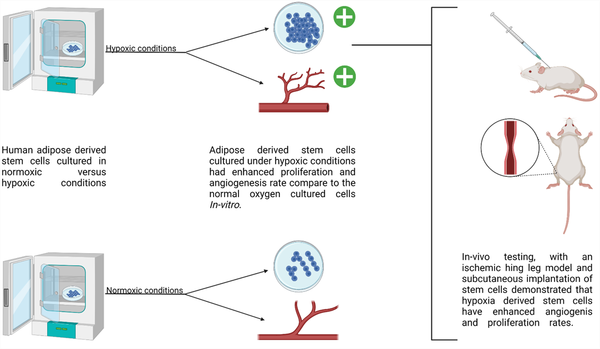-
Home
-
About JCTR
-
Gold Open Access
-
Issues
-
Editorial board
-
Author guidelines
-
Publication fees
-
Online first
-
Special issues
-
News
-
Publication ethics
-
Partners
-
Submit your manuscript
-
Submit your review report
-
Editorial Office
-

This work is licensed under a Creative Commons Attribution-NonCommercial 4.0 International License. ISSN print: 2382-6533 ISSN online: 2424-810X
Volume 8 Issue 1
Hypoxia-preconditioning of human adipose-derived stem cells enhances cellular proliferation and angiogenesis: A systematic review
John P. Garcia, Francisco R. Avila, Ricardo A. Torres, Karla C. Maita1, Abdullah S. Eldaly, Brian D. Rinker, Abba C. Zubair, Antonio J. Forte*, Rachel Sarabia-Estrada
Garcia et al. J Clin Transl Res 2022; 8(1):5
Published online: January 25, 2022
Abstract
Background: Human adipose-derived stem cells (hADSCs) have gained attention lately because of their ease of harvesting and ability to be substantially multiplied in laboratory cultures. Stem cells are usually cultured under atmospheric conditions; however, preconditioning stem cells under hypoxic conditions seems beneficial.
Aim: This systematic review aims to investigate the effect of hypoxia preconditioning and its impact on the proliferation and angiogenic capacity of the hADSCs.
Methods: We performed a systematic review by searching PubMed, Scopus, Embase, and Google Scholar databases from all years through March 22, 2021, following Preferred Reporting Items for Systematic Reviews and Meta-Analyses (PRISMA) guidelines. Medical Subject Headings terms “adipose-derived stem cell,” “Hypoxia,” “cell proliferation,” and “angiogenesis” guided our search. Only articles written in English using experimental models comparing a preconditioned group against a control group of human ADSCs with data on proliferation and angiogenic capacity were included.
Results: Our search yielded a total of 321 articles. Eleven articles met our inclusion criteria and were ultimately included in this review. Two studies induced hypoxia by using hypoxia-inducible factor-1 alpha stabilizing agents, while 9 reached hypoxia by changing oxygen tension conditions around the cells. Four articles conducted in-vivo studies to correlate their in-vitro findings, which proved to be consistent. Although 1 article indicated cell proliferation inhibition with hypoxia preconditioning, the remaining 10 found enhanced proliferation in preconditioned groups compared to controls. All articles showed an enhanced angiogenic capacity of human ADSCs after hypoxia preconditioning.
Conclusion: In this review, we found evidence to support hypoxia preconditioning of human ADSCs before implantation. Benefits include enhanced cell proliferation with a faster population doubling rate and increased secretion of multiple angiogenic growth factors, enhancing angiogenesis capacity.
Relevance for Patients: Although regenerative therapy is a promising field of study and treatment in medicine, much is still unknown. The potential for angiogenic therapeutics with stem cells is high, but more so, if we discover ways to enhance their natural angiogenic properties. Procedures and pathologies alike require the assistance of angiogenic treatments to improve outcome, such is the case with skin grafts, muscle flaps, skin flaps, or myocardial infarction to mention a few. Enhanced angiogenic properties of stem cells may pave the way for better outcomes and results for patients.

DOI: http://dx.doi.org/10.18053/jctres.08.202201.005
Author affiliation
1. Division of Plastic Surgery, Mayo Clinic, Jacksonville, Florida.
2. Transfusion Medicines and Stem Cell Therapy, Department of Laboratory Medicine and Pathology, Mayo Clinic, Jacksonville, Florida, USA
3. Departments of Neurosurgery; Neuroscience; and, Cancer Biology, Mayo Clinic, Jacksonville, Florida.
*Corresponding author
Antonio J. Forte
Division of Plastic Surgery, Mayo Clinic, 4500 San Pablo Rd, Jacksonville, FL 32224.
Phone: 904-953-2073
Fax: 904-953-7368
Email: ajvforte@yahoo.com.br
Handling editor:
Michal Heger
Department of Pharmaceutics, Utrecht University, the Netherlands
Department of Pharmaceutics, Jiaxing University Medical College, Zhejiang, China

